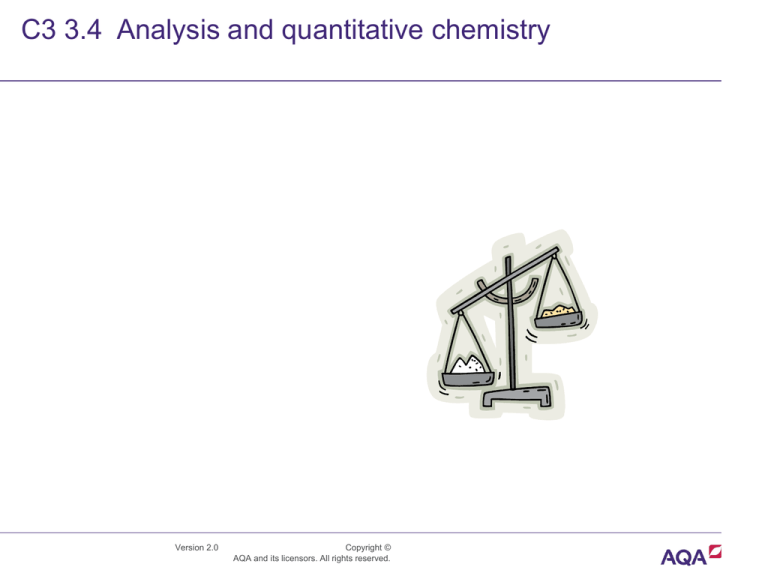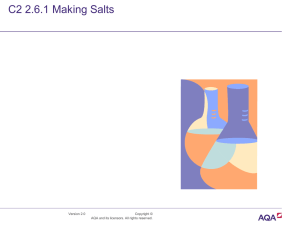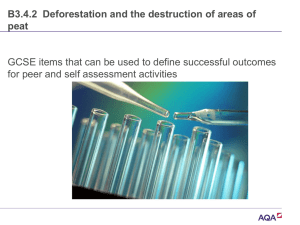
C3 3.4 Analysis and quantitative chemistry
Version 2.0
Copyright ©
AQA and its licensors. All rights reserved.
Using Exam pro items to support successful
outcomes
•
C3 3.4
• Learners will be able to test their progress against learning
outcomes using questions from past AQA GCSE examinations
Version 2.0
Copyright © AQA and its
licensors. All rights reserved.
Foundation Tier QSP 3F 06
•
The use of too much common salt (sodium chloride) in our diet increases the risk of heart
problems. One way to reduce sodium chloride in our diet is to use Low Sodium Salt
instead of common salt.
A student tested Low Sodium Salt to find out if it contained all of the compounds on the list
of ingredients.
(a)
The student added dilute hydrochloric acid to Low Sodium Salt to show that it
contains carbonate ions. Carbon dioxide gas was given off.
(i)
What would the student see that shows a gas is given off?
...............................................................................................................
...............................................................................................................
(1)
Version 2.0
Copyright © AQA and its
licensors. All rights reserved.
C3 3.4
•
(ii)
The student tested the gas given off to show that the gas was carbon dioxide.
Complete the sentence.
When carbon dioxide gas is mixed with limewater
the solution turns ....................................................... .
(1)
(b)
The student tested for magnesium ions. The student added sodium hydroxide
solution to a solution of Low Sodium Salt.
What is the colour of the precipitate that the student would see?
........................................................................................................................
(1)
(c)
The student did a flame test using Low Sodium Salt.
(i)
The flame colour the student saw was yellow. Which compound in Low
Sodium Salt produces this flame colour?
...............................................................................................................
(1)
Version 2.0
Copyright © AQA and its
licensors. All rights reserved.
C3 3.4
•
(ii)
The student did not observe the colour in the flame which would show that
there were potassium ions in the Low Sodium Salt.
Suggest why.
(You will need to state the flame colour of the potassium ions in your answer.)
...............................................................................................................
...............................................................................................................
...............................................................................................................
...............................................................................................................
(2)
(Total 6 marks)
Version 2.0
Copyright © AQA and its
licensors. All rights reserved.
C3 3.4
Mark scheme- Foundation
Q1
Answer
(a) (i)
•
Extra Information
Mark
fizzing / effervescing
1
(a) (ii)
cloudy / milky / white
1
(b)
white
1
(c)
(i)
sodium chloride
1
(c)
(ii)
potassium ions give a lilac flame colour
1
potassium’s flame colour is masked by sodium’s flame colour
1
Total 6
Version 2.0
Copyright © AQA and its
licensors. All rights reserved.
C3 3.4
2. Foundation Tier QSP 3F 09
Drain Buster is used to clear and degrease drains. Sodium hydroxide is the main chemical
substance in Drain Buster.
(a)
A student planned an experiment to find the concentration of the sodium hydroxide
solution in Drain Buster.
The teacher had to dilute the Drain Buster before the student could use it.
Explain why.
........................................................................................................................
........................................................................................................................
........................................................................................................................
........................................................................................................................
Version 2.0
Copyright © AQA and its
licensors. All rights reserved.
•
C3 3.4
•
(b)
In this question you will get marks on using good English, organising information
clearly and using specialist terms where appropriate.
The student wanted to find the volume of hydrochloric acid that reacts with a known
volume of diluted Drain Buster.
Describe how the student could do this by titration.
In your description you should include:
•
the names of pieces of apparatus used
•
the names of the substances used
•
a risk assessment
........................................................................................................................
........................................................................................................................
........................................................................................................................
........................................................................................................................
........................................................................................................................
........................................................................................................................
........................................................................................................................
........................................................................................................................
........................................................................................................................
........................................................................................................................
........................................................................................................................
........................................................................................................................
(6)
(Total 8 marks)
Version 2.0
Copyright © AQA and its
licensors. All rights reserved.
C3 3.4
Mark scheme- Foundation
•
Extra Information
C3 3.4
Mar
k
Q2
Answer
(a)
Drain Buster is a concentrated sodium hydroxide solution that would damage the skin
therefore it is diluted so that it is safe to use for the experiment
1
1
(b)
No relevant content.
Marks awarded for this answer will be determined by the Quality
of Written Communication (QWC) as well as the standard of the
scientific response.
0
Level 1
There is a brief description of the
titration that may include a risk
assessment.
examples of the chemistry points made in the response
•
burette / acid / HCl used correctly
1–2
•
•
•
•
•
•
•
•
Level 2
There is some description of the
titration that may include a risk
assessment.
Level 3
There is a clear, balanced and
detailed description of the titration
and an appropriate risk assessment.
Version 2.0
pipette used for Drain Buster solution / alkali / NaOH correctly
read meniscus at eye level
acid / HCl added dropwise
indicator used
white background/tile
end-point of titration recorded
swirling/mixing
repeat
example of risk assessment points made in the response eg
•
Wear safety goggles – to protect eyes because
3-4
hydrochloric acid is corrosive / irritant and / or
sodium hydroxide is caustic
5-6
Total
8
Copyright © AQA and its
licensors. All rights reserved.
Higher Tier QSP 3H 05
The use of too much common salt (sodium chloride) in our diet increases the risk of heart
problems. One way to reduce sodium chloride in our diet is to use Low Sodium Salt
instead of common salt.
A student tested Low Sodium Salt to find out if it contained both potassium chloride and
sodium chloride and what ions were in the anti-caking agent.
(a)
The student did a flame test.
The flame colour showed that there were sodium ions in the Low Sodium Salt.
The student did not observe the colour in the flame which would show that there
were potassium ions in the Low Sodium Salt.
Suggest why.
(You will need to state the flame colours of sodium ions and potassium ions in your
answer.)
........................................................................................................................
........................................................................................................................
........................................................................................................................
........................................................................................................................
........................................................................................................................
........................................................................................................................
Version 2.0
Copyright © AQA and its
licensors. All rights reserved.
•
C3 3.4
•
The student did a test to find which metal ion was in the anti-caking compound.
The student had not seen any red colour in the flame while doing the flame test.
The student added water to make a solution of Low Sodium Salt.
The student then added sodium hydroxide solution. A white precipitate formed that
was insoluble in excess sodium hydroxide solution.
Use the information to draw a ring around the name of the metal ion that is in the
anti-caking agent.
aluminium
calcium
magnesium
(1)
(c)
A student was provided with the following reagents to test for non-metal ions in the
Low Sodium Salt.
•
•
•
•
Calcium hydroxide solution
Dilute hydrochloric acid
Silver nitrate in solution
Dilute nitric acid
The table shows the tests that student did and the observations that the student
made.
Tests
Observations
Dilute nitric acid was added to Low Sodium Salt
The mixture fizzed and the gas given off
turned limewater cloudy.
Excess nitric acid was added to the Low Sodium Salt,
and then silver nitrate solution was added.
A white precipitate formed in the solution.
Version 2.0
Copyright © AQA and its
licensors. All rights reserved.
C3 3.4
•
i)
From the table what conclusions can you make about the non-metal ions that
are in the Low Sodium Salt?
Explain your conclusions.
...............................................................................................................
...............................................................................................................
...............................................................................................................
...............................................................................................................
(2)
(ii)
Another student used hydrochloric acid instead of nitric acid for the tests
shown in the table.
Describe what this student would observe and explain why this student’s
conclusions would not be valid.
...............................................................................................................
...............................................................................................................
...............................................................................................................
...............................................................................................................
...............................................................................................................
...............................................................................................................
(3)
(Total 9 marks)
Version 2.0
Copyright © AQA and its
licensors. All rights reserved.
C3 3.4
Mark scheme- Higher
•
Q1
Answer
(a)
sodium – yellow flame
potassium – lilac flame
potassium’s flame colour is masked by sodium’s flame colour
1
1
1
(b)
magnesium
1
(c)
(i)
carbonate (ions) must be present because carbon
dioxide was produced when nitric acid was added
chloride (ions) must be present because a white precipitate
formed when acidified silver nitrate solution was added
1
the student would make the same observations using
either hydrochloric acid or nitric acid
any conclusion would not be valid because hydrochloric
acid contains chloride (ions)
the explanation is that these chloride (ions) would cause
a white precipitate without the presence of the low
sodium salt / sodium chloride / potassium chloride
1
(c)(ii)
Extra Information
Total
Version 2.0
Copyright © AQA and its
licensors. All rights reserved.
C3 3.4
Mark
1
1
1
9
Q2 Higher Tier QB0 3H 19 (a)
.
(a)
This label has been taken from a bottle of vinegar.
Vinegar is used for seasoning foods. It is a solution of ethanoic acid in water.
In an experiment, it was found that the ethanoic acid present in a 15.000
cm3.sample of vinegar was neutralised by 45.000cm3 of sodium hydroxide solution,
of concentration 0.20 moles per cubic decimetre (moles per litre).
The equation which represents this reaction is
CH3COOH + NaOH → CH3COONa + H2O
Calculate the concentration of the ethanoic acid in this vinegar:
Version 2.0
Copyright © AQA and its
licensors. All rights reserved.
•
C3 3.4
•
(i)
in moles per cubic decimetre (moles per litre);
...........................................................................................................................
...........................................................................................................................
...........................................................................................................................
...........................................................................................................................
Concentration =................................... moles per cubic decimetre
(2)
(ii)
in grams per cubic decimetre (grams per litre).
Relative atomic masses: H = 1; C = 12; O = 16.
...........................................................................................................................
...........................................................................................................................
...........................................................................................................................
Concentration = .................................. grams per cubic decimetre
(2)
Version 2.0
Copyright © AQA and its
licensors. All rights reserved.
C3 3.4
Mark scheme- Higher
Q2
Answer
(a)
(i)
e.g. moles NaOH = moles of acid
or formula:
0.2 × = 0.009
•
Extra Information
Mark
rounding to 0.01 loses mark
= 0.009 × = 0.6(M)
15M1 = 0.2 × 45
M1 = 0.6(M)
ecf for arithmetical error
correct answer 2 marks
(a) (ii)
36
ecf – (a)(i) × 60
relative formula mass of ethanoic acid
= 60 for 1 mark
Copyright © AQA and its
licensors. All rights reserved.
1
1
correct answer 2 marks
0.6 × 60 gets 1 mark
1
0.6 × incorrect molar mass gains
second mark only
1
Total
Version 2.0
C3 3.4
4
•
C3 3.4







